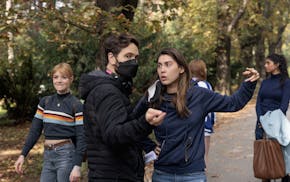A firearm used to wound a Minneapolis police officer on the city's North Side earlier this month has been linked to at least five other Twin Cities shootings since June 1, according to a recently filed federal affidavit.
Investigators recovered the 9mm Glock 19, illegally converted with a "switch" to make it fully automatic, alongside 15 discharged cartridge casings from a crashed suspect vehicle on Friday, Aug. 11. — shortly after officer Jacob Spies was struck in the shoulder.
Spies, a seven-year veteran of the force, was tailing a group of robbery suspects in an unmarked police vehicle when a barrage of gunfire suddenly erupted toward him. One bullet pierced his right shoulder, narrowly missing a major artery, before lodging between his chest cavity and pectoral muscle, federal charges say.
Spies was treated at North Memorial Health Hospital and released.
Four suspects, including a teenage boy, were arrested in connection with what Chief Brian O'Hara repeatedly called "an ambush-style attack." Frederick Leon Davis Jr., 19, was later charged with attempted murder by the Hennepin County Attorney's Office alongside a 20-year-old female accomplice after witnesses accused him of being the shooter.
Police found two firearms in the car: The fully automatic Glock 19, equipped with an extended magazine and switch, on the front floorboard where Davis was sitting, as well as a Polymer 80 "ghost gun" without serial numbers in the back where the juvenile was sitting, charges say.
Forensic analysts fed the strewn ammunition through the National Integrated Ballistic Information Network (NIBIN), which helps decode the tiny, unique markings every firearm leaves on a shell casing and match them to shells found at other crime scenes.
A preliminary analysis indicated that the automatic Glock had fired 12 shots and the Polymer 80 had fired three shots. Ballistics evidence linked that same Glock to at least five other area shootings this summer, but the affidavit did not specify which ones —or indicate whether Davis was implicated.
Minneapolis police declined to comment Wednesday, citing an open federal investigation.
Davis also faces federal charges for unlawfully possessing a machine gun.
The affidavit filed last week by an agent with the Bureau of Alcohol, Tobacco, Firearms and Explosives (ATF) also reveals several new details about the chaotic events leading up to shooting.
According to the criminal complaint:
Spies was working on a focused enforcement detail with the Hennepin County Sheriff's Office when he heard dispatch issue a BOLO — "be on the lookout" call — for a stolen Chevrolet Equinox involved in a violent robbery and fleeing police earlier that evening.
About an hour later, Spies saw the vehicle and began to follow it while calling for backup. As he crested a hill near the 4300 block of Colfax Avenue N., Spies was hit by a volley of automatic gunfire — from seemingly two directions — and felt his arm go numb.
Spies accelerated west on Webber Parkway to Fremont Avenue N., where a colleague pulled him from the vehicle and raced to the hospital.
Shortly after the shots were fired, backup officers saw the same Chevy Equinox and began a high-speed pursuit that continued for 26 blocks to 21st and Upton avenues N., where the suspect vehicle crashed into a parked car.
Two suspects, later identified as Davis and Nevaeh Page, fled the SUV on foot. A teenage boy "stumbled out of the car with an apparent head injury," charges say, while another 19-year-old man remained in the vehicle until he was arrested.
That 19-year-old backseat passenger later told authorities that the foursome was headed to a party when Davis noticed an unknown white sedan tailing them. As the passenger turned to look our the rear window, he heard Davis say: "It's gonna happen right here."
Davis then threw the SUV in park and got out of the vehicle. A nearby homeowner retrieving his pet reported seeing someone matching Davis' description unload a flurry of shots.
Neither state nor federal charges indicate whether investigators believe Davis or his accomplices knew who they were targeting. In the immediate aftermath of the shooting, O'Hara raised doubts about whether the gunmen meant to target a police officer.
In addition to driving an unmarked sedan with tinted windows, Spies was wearing a blue Minneapolis police T-shirt rather than full uniform and may not have been readily identifiable to passing motorists.

Perfection comes with a reward for 3 teams in baseball Metro Top 10

Shakopee Mdewakanton tribe applies to put 815 acres in southwest metro into trust

Lakeville teachers vote to authorize strike

Chaska native's directorial debut 'Tarot' will be in 3,500 theaters

